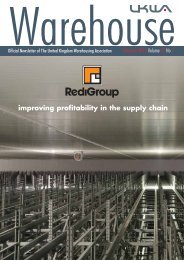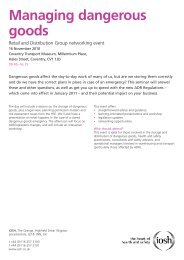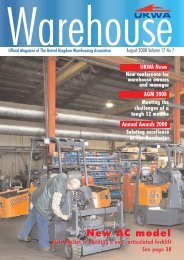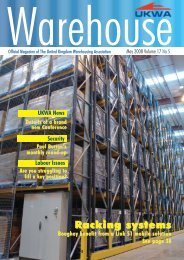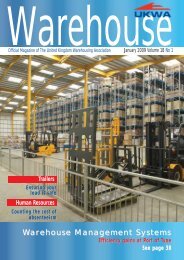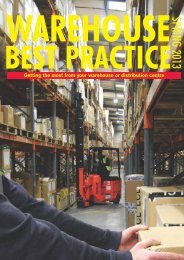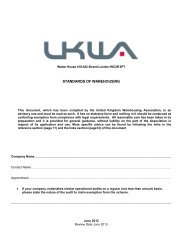Pictured - United Kingdom Warehousing Association
Pictured - United Kingdom Warehousing Association
Pictured - United Kingdom Warehousing Association
You also want an ePaper? Increase the reach of your titles
YUMPU automatically turns print PDFs into web optimized ePapers that Google loves.
Viewpoint 21Continued from page 19The starting point is to optimise yourexisting warehouse operations to meetthe current and future needs of the business,in line with your growth projections.The key areas that need to havean established strategy are an appropriatewarehouse and inventory managementtechnique (to optimise workflowand costs); optimised target inventory(holding cost vs ordering cost vs service);optimised warehouse design/stores layout,handling practices and workflows;tactical stock location(s) and pickingstrategy; appropriate manual and/orautomated Materials Handling Systems;a clear WMS operational requirementspecification; a performance measurementstrategy(and/or tool), toidentify activitycosts within thewarehouse andcustomer serviceperformance.This maymake you thinkthat simply outsourcingyourwarehouse toone of the manythird partyproviders wouldbe an easieroption to haveas your ‘instant’optimisationstrategy.However, this is not the right approach ifyou do not understand your currentwarehouse operations and thereforewarehouse requirements in detail.(Would you consider having an artificialheart before you were aware of all thefacts and the options available to you?).To outsource you must have a clearunderstanding of exactly what you areoutsourcing, how to measure the performanceof your provider and how thecosts of outsourcing compare to thecosts of running your own optimisedwarehouse. I am a keen advocate ofoutsourcing many warehouse and logisticsoperations and frequently do so forcompanies across the UK and Europewhen it is appropriate and there is aclear understanding of the businessneeds with a clear strategy.To develop a good warehouse strategy(whether in-house or outsourced) youwill need to review your current operationand understand the type of operationyou will need in the future as thebusiness changes. This will include a fullreview of the following areas; the interface/interactionbetween warehousingand other operations/departments;product flows and volumes at SKU orfamily level; seasonal fluctuations foreach product group; increased productlines and projected changes to productfamily type; product storage requirements,including number on pallets,outer packaging, cartons, SKU anditems; goods inand putaway/stowageroutines andpicking, packingand despatchprocedures;stock and inventorymanagementrequirements;inboundproduct profilesand handlingrequirements;customer serviceand deliverycommitmentsand order cut-offtimes; stock andinventory data todetermine stock levels and pick face layouts;returns handling and sortationoperation; slow moving and obsoletestock policy; stock management systemor WMS and reporting requirements;warehouse operational costs.Once you have acknowledged thatyour warehouse is at the heart of yoursupply chain, combined with an understandingof how it should work, andsubsequently implement a strategy tomaintain its health and longevity; thenthe hard work is done.Remember a business will rarely dieof a broken heart, but the longer youtake to address the cause of theheartache, the longer the negativeimpact and effects can last.www.ukwa.org.uk August 2012







